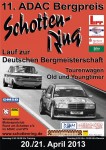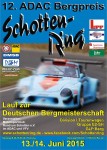| Title: | ADAC Bergpreis Schottenring |
| Place: | Schotten / Rudingshain |
| Tracklength: | 3033 metres |
| Elevation change: | 160 metres |
| Altitude finishline: | 630 metres |
| GPS coordinates: | 50° 31′ 42.6″ – 9° 10′ 47.9994″ |
| Website: | www.schottenring.de |
| Fastest Time: | 5:07,815 (4 runs) |
| Average Speed: | 141,89 km/h |
Is there missing or incorrect information on this page? Please let me know in the comments below, or send me an email.
| Date | Winner | Car | Time | Final | |
|---|---|---|---|---|---|
| 20-21/04/2013 | Herbert Stolz |  | Porsche 935 DPII | 5:10,057 | Results |
| 13-14/06/2015 | Holger Hovemann |  | Opel Kadett C GTR | 5:23,793 | Results |
| 23-24/04/2016 | Herbert Pregartner |  | Porsche 911 GT2 RSR | 4:26,297 | Results |
| 29-30/04/2017 | Herbert Stolz |  | Porsche 935 DPII | 5:16,202 | Results |
| 28-29/04/2018 | Herbert Pregartner |  | Porsche 911 GT2 RSR | 5:07,815 | Results |
| 27-28/04/2019 | Holger Hovemann |  | Opel Kadett C GTR | 5:23,083 | Results |
The Schottenring is a street circuit used for the first time all the way back in 1925. The racetrack was first used for motorcycles who competed in the “Rund um Schotten” prize. It hosted a world championship race in 1953, but many drivers skipped the race in protest of the bad safety measures. Car races were held in 1938 and 1948-1950. After 1955 racing stopped altogether as the track was too dangerous. In 1969 motorsport returned with regularity motorraces. The cars also returned in the form of an annual Hillclimb in part of the track. This Hillclimb lasted until 1983. The current Schottenring Historic Motorcycle Grand Prix runs on a small city track outside of the actual racecourse.
The original 16+ kilometre long Schottenring ran clockwise from Schotten towards Götzen uphill, and then via Rudingshain back down to Schotten. The Hillclimb uses three kilometres of the old course, starting in Rudingshain running counterclockwise towards the top of the track.
The town of Schotten is situated at the foot of the Vogelsberger Mountains. These mountains developed some 20 million years ago and are of volcanic origin. Today the Vogelsberg appears as a large single shaped hump in the landscape. This is typical of a shield volcano, where lava is distributed slow and more or less evenly in all directions. The Vogelsberg Mountains are slightly different in the fact that they consist of multiple small volcanoes. The lava flows of these volcanoes flowed over and next to eachother, creating the largest Basalt deposits in central Europe. The Vogelsberg mountains reach an altitude of 773m. It is a beloved wintersport area and in the summer a great place for hiking trip.
The Schottenring is situated 45 kilometres to the east of Giessen and 50 kilometres to the west of Fulda.





